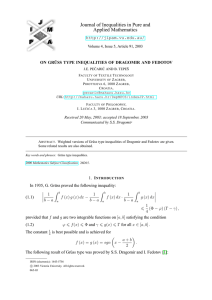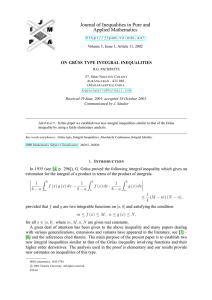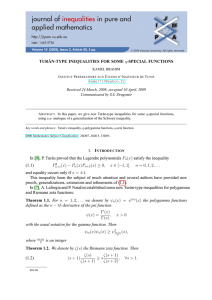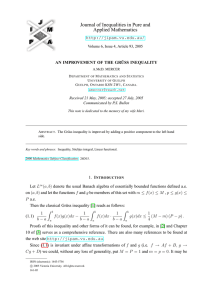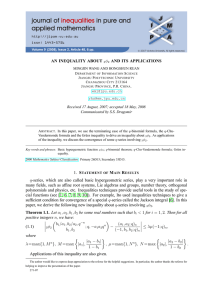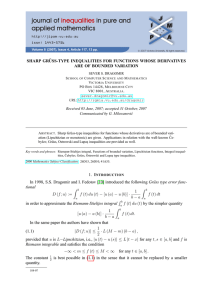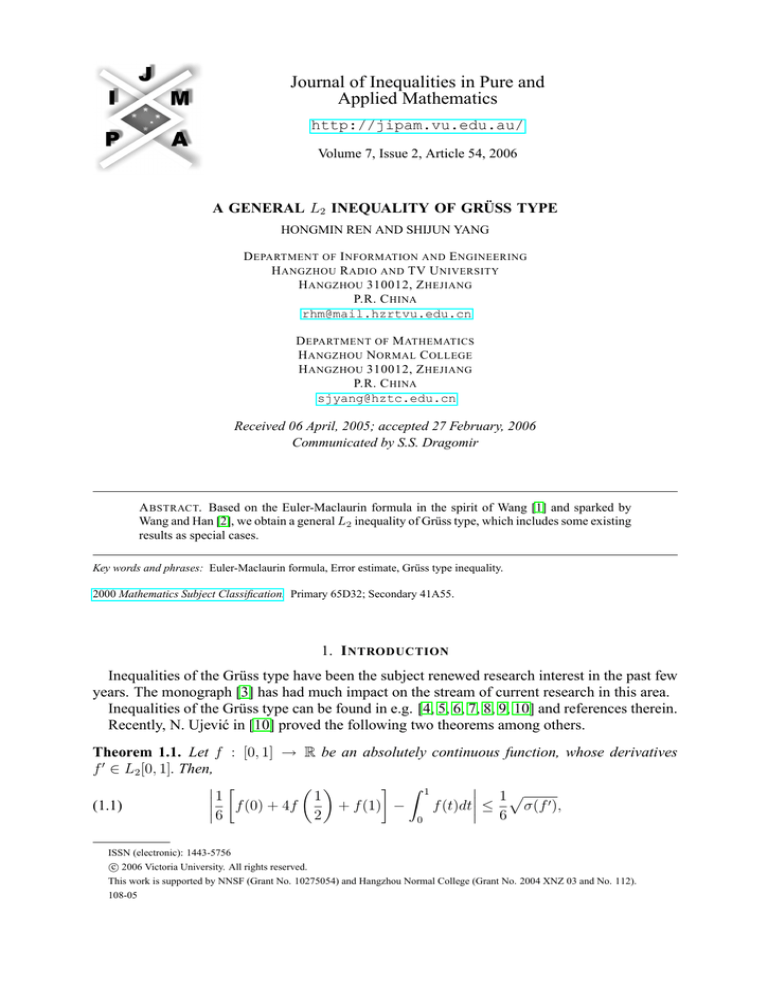
Journal of Inequalities in Pure and
Applied Mathematics
http://jipam.vu.edu.au/
Volume 7, Issue 2, Article 54, 2006
A GENERAL L2 INEQUALITY OF GRÜSS TYPE
HONGMIN REN AND SHIJUN YANG
D EPARTMENT OF I NFORMATION AND E NGINEERING
H ANGZHOU R ADIO AND TV U NIVERSITY
H ANGZHOU 310012, Z HEJIANG
P.R. C HINA
rhm@mail.hzrtvu.edu.cn
D EPARTMENT OF M ATHEMATICS
H ANGZHOU N ORMAL C OLLEGE
H ANGZHOU 310012, Z HEJIANG
P.R. C HINA
sjyang@hztc.edu.cn
Received 06 April, 2005; accepted 27 February, 2006
Communicated by S.S. Dragomir
A BSTRACT. Based on the Euler-Maclaurin formula in the spirit of Wang [1] and sparked by
Wang and Han [2], we obtain a general L2 inequality of Grüss type, which includes some existing
results as special cases.
Key words and phrases: Euler-Maclaurin formula, Error estimate, Grüss type inequality.
2000 Mathematics Subject Classification. Primary 65D32; Secondary 41A55.
1. I NTRODUCTION
Inequalities of the Grüss type have been the subject renewed research interest in the past few
years. The monograph [3] has had much impact on the stream of current research in this area.
Inequalities of the Grüss type can be found in e.g. [4, 5, 6, 7, 8, 9, 10] and references therein.
Recently, N. Ujević in [10] proved the following two theorems among others.
Theorem 1.1. Let f : [0, 1] → R be an absolutely continuous function, whose derivatives
f 0 ∈ L2 [0, 1]. Then,
Z 1
1
1p
1
0
≤
(1.1)
f
(0)
+
4f
+
f
(1)
−
f
(t)dt
6
6 σ(f ),
2
0
ISSN (electronic): 1443-5756
c 2006 Victoria University. All rights reserved.
This work is supported by NNSF (Grant No. 10275054) and Hangzhou Normal College (Grant No. 2004 XNZ 03 and No. 112).
108-05
2
H ONGMIN R EN
AND
S HIJUN YANG
where σ(·) is defined by
σ(f ) =
(1.2)
Z
kf k22
−
1
2
f (t)dt .
0
Inequality (1.1) is sharp in the sense that the constant
1
6
cannot be replaced by a smaller one.
Theorem 1.2. Under the assumptions of Theorem 1.1, for any x ∈ [0, 1], we have
Z 1
1
1 p
0
≤ √
f (x) − x −
(1.3)
[f
(1)
−
f
(0)]
−
f
(t)dt
2 3 σ(f ).
2
0
√
Inequality (1.3) is sharp in the sense that the constant 1/(2 3) cannot be replaced by a smaller
one.
Based on the Euler-Maclaurin formula in the spirit of Wang [1] and sparked by Wang and
Han [2], we obtain a general L2 inequality of the Grüss type under very natural assumptions.
Our results improve and generalize some existing observations.
2. A L2
VERSION OF
G RÜSS T YPE I NEQUALITY
In what follows, let f be defined on [0, 1],
Z
||f ||2 =
1
2
f (t)dt
0
and L2 [0, 1] = {f | ||f ||2 < ∞}.
Some more notations and the following lemmas are needed before we proceed. In the rest of
the paper, a standing assumption is that x ∈ [0, 1], n is a positive integer and 0 = t0 < t1 <
· · · < tn = 1 is an equidistant subdivision of the interval [0, 1] such that ti+1 − ti = h =
1/n, i = 0, 1, . . . , n − 1.
We start with the following lemma.
Lemma 2.1 ([1], cf. [11]). Let f : [0, 1] → R be such that its (k − 1)th derivative f (k−1)
is absolutely continuous for some positive integer k. Then for any x ∈ [0, 1], we have the
Euler-Maclaurin formula
Z 1
(2.1)
f (t)dt = Qk (f, x) + Ek (Qk ; f, x),
0
where
Qk (f, x) = h
(2.2)
n−1
X
f (ti + xh) −
ν=1
i=0
hk
Ek (Qk ; f, x) =
k!
k
X
f (ν−1) (1) − f (ν−1) (0)
Z
ν!
Bν (x)hν ,
1
ek (x − nt)f (k) (t)dt,
B
0
ek (t) := Bk (t − btc) where Bk (t) is the kth Bernoulli polynomial.
and B
Lemma 2.2. For any x, y ∈ [0, 1], we have
Z 1
k−1
2
ek (x − t)B
ek (y − t)dt = (−1) (k!) B
e2k (x − y).
(2.3)
B
(2k)!
0
J. Inequal. Pure and Appl. Math., 7(2) Art. 54, 2006
http://jipam.vu.edu.au/
A G ENERAL L2 I NEQUALITY
OF
G RÜSS T YPE
3
Proof. We use a technique of [2]. Setting n = 1, t0 = 0 and
(−1)k k! e
B2k (x − t),
(2k)!
f (t) =
in (2.1), then we have
ek (x − t).
f (k) (t) = B
e2k (t) and the property of B2k (t) (see e.g. [12]), we can easily get
By the periodicity of B
Z 1
Z 1
e
(2.4)
B2k (x − t)dt =
B2k (t)dt = 0.
0
0
Then we have
Z
1
f (t)dt = 0.
(2.5)
0
From (2.2) and the periodicity of this special function f , we have for any y ∈ [0, 1]
Qk (f, y) = f (y) −
k
X
f (ν−1) (1) − f (ν−1) (0)
ν!
ν=1
(2.6)
Bν (y) = f (y),
Z
1 1 e
ek (x − t)dt.
Ek (Qk ; f, y) =
Bk (y − t)B
k! 0
Now from (2.1), (2.5) and (2.6), (2.3) follows.
By Lemmas 2.1 and 2.2, we have
Corollary 2.3. Suppose the conditions in Lemma 2.1 hold, then we have
(2.7)
Ek (Qk ; f, x) ≤ hk ck (2)kf (k) k2 ,
where
s
ck (2) =
(−1)k−1
B2k .
(2k)!
Remark 2.4. From Corollary 2.3, the right side of (2.7) is independent of x.
Lemma 2.5 ([1], cf. [11]). Suppose that the following quadrature rule
Z 1
m−1
X
(2.8)
f (t)dt =
pj f (xj )
0
j=0
is exact for any polynomial of degree ≤ k − 1 for some positive integer k. Let f : [0, 1] → R be
such that its (k − 1)th derivative f (k−1) is absolutely continuous. Then we have
Z 1
(2.9)
f (t)dt = Q(f ) + Ek (Q; f ),
0
where
Q(f ) = h
n−1 m−1
X
X
pj f (ti + xj h),
i=0 j=0
(2.10)
hk
Ek (Q; f ) =
k!
J. Inequal. Pure and Appl. Math., 7(2) Art. 54, 2006
Z
1
gk (nt)f (k) (t)dt,
0
http://jipam.vu.edu.au/
4
H ONGMIN R EN
AND
S HIJUN YANG
and
gk (t) =
(2.11)
m−1
X
ek (xj − t) − Bk (xj )).
pj (B
j=0
By the Hölder inequality, we have
|Ek (Q; f )| ≤ ck (2)||f (k) ||2 ,
(2.12)
where
hk
||gk ||2 .
k!
Remark 2.6. It is easy to see that (2.12) is sharp in the sense that the constant ck (2) cannot be
replaced by a smaller one.
ck (2) =
(2.13)
We are now able to find an explicit expression for ck (2).
Theorem 2.7. Suppose that the quadrature rule (2.3) is exact for any polynomial of degree
≤ k − 1 for some positive integer k. Then the following equality is valid.
( m−1
) 12
(−1)k−1 (k!)2 e
hk X
pi pj
B2k (xi − xj ) + Bk (xi )Bk (xj )
(2.14)
ck (2) =
.
k! i,j=0
(2k)!
Proof. A straightforward computation on using (2.4) and Lemma 2.2 gives
Z 1
m−1
X
2
ek (xi − t) − Bk (xi ) B
ek (xj − t) − Bk (xj )) dt
pi pj
B
kgk k2 =
0
i,j=0
=
m−1
X
i,j=0
Z
pi pj
1
e
e
Bk (xi − t)Bk (xj − t) + Bk (xi )Bk (xj ) dt
0
m−1
m−1
(−1)k−1 (k!)2 X
1 X
e
=
pi pj B2k (xi − xj ) +
pi pj Bk (xi )Bk (xj ),
(2k)!
k!
i,j=0
i,j=0
which in combination with (2.13) proves the conclusion as desired.
3. E XAMPLES
Example 3.1. For the Trapezoid rule, m = 2, x0 = 0, x1 = 1, p0 = p1 = 1/2. It is well known
that the Trapezoid rule has degree of precision 1 (k = 2). A direct calculation using (2.14)
yields
h2
h
c2 (2) = √ .
c1 (2) = √ ,
2 30
2 3
If f is absolutely continuous, then we can obtain
Z 1
1
1
0
≤ √
(3.1)
[f
(0)
+
f
(1)]
−
f
(t)dt
2
2 3 ||f ||2 .
0
R1
Replacing f (t) by f (t) − t 0 f (t)dt in (3.1), we get
Z 1
1
1 p
0
[f (0) + f (1)] −
≤ √
(3.2)
f
(t)dt
2
2 3 σ(f ),
0
since the Trapezoid rule has degree of precision 1.
J. Inequal. Pure and Appl. Math., 7(2) Art. 54, 2006
http://jipam.vu.edu.au/
A G ENERAL L2 I NEQUALITY
OF
G RÜSS T YPE
Example 3.2. Consider the following quadrature rule
Z 1
1
1
(3.3)
f (t)dt = x −
f (0) + f (x) − x −
f (1),
2
2
0
5
x ∈ [0, 1],
which has degree of precision 1 (k = 2). A direct calculation using Corollary 2.3 gives
1
c1 (2) = √ ,
2 3
from which and the similar argument of Example 3.1, follows (1.3).
Example 3.3. For Simpson’s rule, m = 3, x0 = 0, x1 = 1/2, x2 = 1, p0 = p2 = 1/6,
p1 = 2/3. It is well known that Simpson’s rule has degree of precision 3 (k = 4). A direct
calculation leads to the following.
c1 (2) =
h
;
6
c3 (2) =
h3
√
;
48 105
c2 (2) =
h2
√ ;
12 30
c4 (2) =
h4
√ .
576 14
The inequality (2.12) in combination with c1 (2) = h/6 yields
Z 1
1
1 0
1
f (0) + 4f
≤ ||f ||2 .
+
f
(1)
−
f
(t)dt
6
6
2
0
R1
Again replacing f (t) by f (t) − t 0 f (t)dt in the above inequality, we easily get Theorem 1.1.
R EFERENCES
[1] X.H. WANG, Remarks on some quadrature formulas, Math. Numer. Sin. (in Chinese), 3 (1978),
76–84.
[2] X.H. WANG AND D.F. HAN, Computational complexity of numerical integrations, Sci. China Ser.
A (in Chinese), 10 (1990), 1009–1013.
[3] D.S. MITRINOVIĆ, J. PEČARIĆ AND A.M. FINK, Inequalities Involving Functions and their
Integrals and Derivatives, Kluwer Academic, Dordrecht, (1994).
[4] S.S. DRAGOMIR, Some integral inequalities of Grüss type, Indian J. Pure Appl. Math., 31 (2000),
397–415.
[5] S.S. DRAGOMIR, A generalization of Grüss’s inequality in inner product spaces and applications,
J. Math. Anal. Appl., 237 (1999), 74–82.
[6] S.S. DRAGOMIR, A Grüss type discrete inequality in inner product spaces and applications, J.
Math. Anal. Appl., 250 (2000), 494–511.
[7] Lj. DEDIĆ, M. MATIĆ AND J. PEČARIĆ, Some inequalities of Euler-Grüss type, Computers
Math. Applic., 41 (2001), 843–856.
[8] S.S. DRAGOMIR AND S. WANG, An inequality of Ostrowski-Grüss’ type and its applications to
the estimation of error bounds for some special means and for some numerical quadrature rules,
Computer Math. Appl., 33(11) (1997), 15–20.
[9] M. MATIĆ, Improvement of some inequalities of Euler-Grüss type, Computers Math. Applic., 46
(2003), 1325–1336.
[10] N. UJEVIĆ, Sharp inequalities of Simpson type and Ostrowski type, Computers Math. Applic., 48
(2004), 145–151.
J. Inequal. Pure and Appl. Math., 7(2) Art. 54, 2006
http://jipam.vu.edu.au/
6
H ONGMIN R EN
AND
S HIJUN YANG
[11] Q. WU AND S. YANG, A note to Ujević’s generalization of Ostrowski’s inequality, Appl. Math.
Lett., in press.
[12] M. ABRAMOWITZ AND I.A. STEGUN (Eds), Handbook of Mathematical Functions with Formulas, Graphs and Mathematical Tables, Tenth printing, Applied Math. Series 55, (National Bureau
of Standards, Washington, D.C., 1972).
J. Inequal. Pure and Appl. Math., 7(2) Art. 54, 2006
http://jipam.vu.edu.au/

